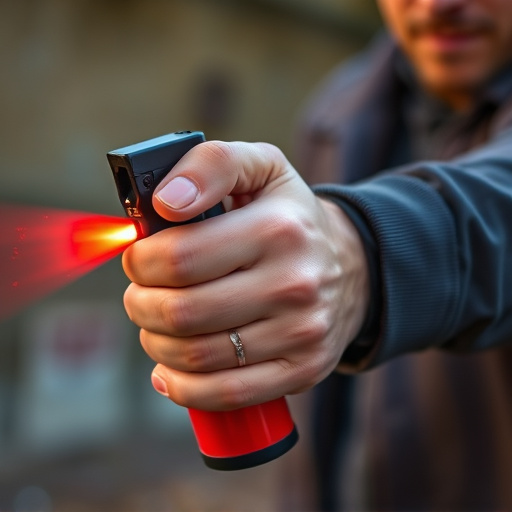This text explores the science and application of pepper spray, focusing on capsaicin as the active ingredient causing its heat and deterrence effects by binding to pain receptors. It highlights two primary delivery methods—spraying directly onto targets and aerosol canisters—each with advantages for specific scenarios like crowd control or personal protection. Safety is paramount when handling police-grade pepper spray, emphasizing training in technique, storage, and legal compliance to minimize risks to users and bystanders while ensuring effective de-escalation tactics. Understanding the best delivery methods for pepper spray is crucial for informed self-defense strategies and adherence to global legal guidelines.
“Discover the powerful compound behind pepper spray, a tool used globally for law enforcement and self-defense. This article unravels the science behind its active ingredient, capsaicin, and explores the evolution of delivery systems—aerosol, gel, and solid forms—each with unique advantages. We delve into safety protocols, crucial for responsible use, and examine legal frameworks that govern these compounds, highlighting best pepper spray delivery methods for optimal effectiveness and compliance.”
- Understanding Pepper Spray Chemistry: The Role of Capsaicin
- Effective Delivery Systems: Aerosol vs. Gel vs. Solid Forms
- Safety Considerations and Best Practices for Use
- Legal Implications and Regulations Governing Pepper Spray Compounds
Understanding Pepper Spray Chemistry: The Role of Capsaicin
Pepper spray, a powerful self-defense tool, is based on the compound capsaicin, which gives hot peppers their heat. Understanding capsaicin’s chemistry is key to appreciating its effectiveness as a deterrent. This natural compound binds to pain receptors in the eyes, nose, and respiratory system, triggering a burning sensation and temporary incapacitation.
Different pepper spray formulations utilize various delivery methods—a crucial consideration when choosing the best pepper spray for your needs. Spraying directly onto the target area ensures maximum exposure, while aerosol canisters offer portability and convenience. Knowing how capsaicin interacts with the body and understanding delivery mechanisms helps users make informed decisions about self-defense strategies involving pepper spray.
Effective Delivery Systems: Aerosol vs. Gel vs. Solid Forms
The effectiveness of pepper spray depends significantly on its delivery system. Aerosol forms are the most common, utilizing pressurized cans to disperse a fine mist of capsaicin oil, the active ingredient. This method offers wide coverage and rapid effect, making it ideal for crowd control and tactical situations. However, wind or atmospheric conditions can impact accuracy and range.
Alternatively, gel and solid formulations provide targeted delivery. Gel pepper spray is thicker, allowing for closer range and better stickiness, ensuring the capsaicin makes direct contact with the target. Solid forms are often in granular or powdery states, requiring direct contact but offering precise application. These methods are favored in situations where accuracy is paramount, such as tactical raids or personal protection. The choice between these delivery systems ultimately depends on the specific use case and environmental conditions.
Safety Considerations and Best Practices for Use
When handling and using police-grade inflammatory pepper spray, safety is paramount. It’s crucial to employ best practices to ensure minimal risk to both users and bystanders. The choice of delivery method plays a significant role in this regard. Aerosol canisters are commonly used due to their ease of application, allowing for a quick and even dispersion of the agent. However, they can be affected by wind or incorrect angle of use, potentially leading to off-target effects. For more controlled scenarios, advanced spray systems that offer directed streams or precision bursts are ideal, enabling users to target specific areas while minimizing over-spray.
Training is essential for learning the best pepper spray delivery methods. This includes understanding distance, angle, and pressure control. Users should be taught to aim at the eyes and face, as this area provides the fastest de-escalation effect. Regular practice sessions can help maintain proficiency and ensure that officers or individuals are prepared to handle situations effectively while adhering to safety protocols. Additionally, proper storage and handling of pepper spray compounds are vital to prevent accidental discharge or degradation of the product.
Legal Implications and Regulations Governing Pepper Spray Compounds
The legal implications and regulations governing pepper spray compounds vary significantly across jurisdictions, reflecting a delicate balance between public safety and individual rights. In many countries, law enforcement agencies are subject to strict guidelines when employing pepper spray as a non-lethal force option. These regulations dictate not only the types of pepper spray compounds that can be used but also the specific delivery methods considered best practices to ensure effectiveness and minimize harm. For instance, regulations often mandate the use of aerosol cans with precise nozzles to control spray distribution, aiming for direct contact with the target’s eyes and face without causing indiscriminate damage or injury.
Compliance with local, state, or federal laws is mandatory for police forces employing pepper spray. Non-compliance can lead to legal repercussions for officers and departments alike, including civil lawsuits and administrative penalties. The best pepper spray delivery methods are those that offer both accuracy and minimal overreach, ensuring the safety of bystanders and adhering to the principle of proportionality in law enforcement actions. Staying updated on evolving regulations is crucial for police forces to maintain legality and public trust while employing these powerful tools.
In conclusion, understanding the chemistry of pepper spray compounds, like capsaicin, and exploring delivery methods such as aerosols, gels, and solids, is key to selecting the best pepper spray for your needs. Safety considerations and legal regulations must be rigorously followed to ensure responsible use. By adhering to best practices, individuals can leverage the power of these compounds effectively while mitigating potential risks and staying within legal boundaries.
